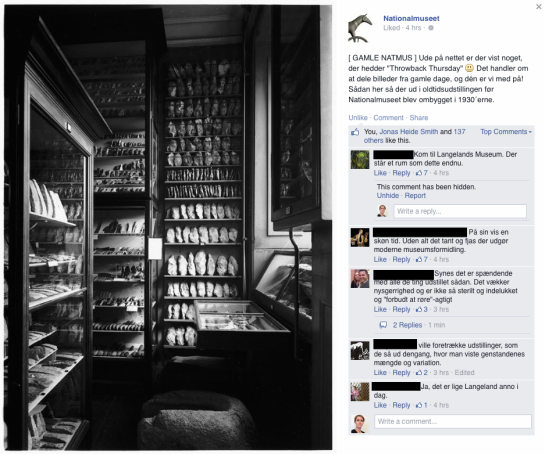For a while I’ve been pondering change and trends in museums. In my article, ‘Museum metamorphosis à la mode’, I suggest that certain museum developments may correspond to a fashion logic, as evident in trends of interest running across the museum sector, and in how keeping up with current culture has become as important, and cooler, than serving as custodians of the past.
The V&A’s Rapid Response Collection is a very interesting example of this, where ‘[o]bjects are collected in response to major moments in history that touch the world of design and manufacturing. This new strategy helps the V&A to engage in a timely way with important events that shape, or are shaped by design, architecture and technology.’ (http://www.vam.ac.uk/content/articles/r/rapid-response-collecting/)
Louboutin’s 2013 Nudes collection, for example (the collection is not fashion specific, by the way, but I choose this example because it relates to my domain in particular), was thus recognised as representing a significant sociocultural shift, as ‘[t]his was the first time that a major fashion house had adjusted its definition of nude to include skin colours other than white’. (Rather shocking, really, that it has taken so long). Furthermore, the collection’s curators leverage Twitter and Instagram to ask for the public’s suggestions for new accessions; another museology-of the-current trend.

‘Fifi’ pump in five nude shades, designed by Christian Louboutin Ltd, 2013. Photo © Victoria and Albert Museum, London
But aside from this movement towards matching and musealising the Zeitgeist, I also detect a trend for nostalgia on the rise. I’ve written about the death and the resurrection of the diorama elsewhere, one of my favourite examples of an altmodish museum technology which nevertheless has a unique didactic and experiential quality, and which furthermore appeals to our yearning for the past.
Another surprisingly strong example of this came up yesterday on Facebook, where the National Museum of Denmark latched on to the ‘Throwback Thursday’ trend on social media, and posted a vintage photo from the museum galleries. Interestingly, the majority of responses expressed a nostalgia for this kind of museum display, with remarks such as ‘It’s actually really beautiful. When I was a child, the National Museum was more magical, lots of objects and hardly any explanations – that was cool’ and ‘would prefer exhibitions as they looked back then, showing the quantity and variety of objects’.
It is interesting, I think, that the public responds in this way (disclaimer: I have not been checking out who ‘the public’ is in this case – some of the other comments seem to come from museum people, and the quoted commentators may also represent a bias, it’s only one instance and an unrepresentative sample, etc. – nevertheless), perhaps a little differently from what the museum expected.
From a museum history perspective this type of display is terribly out-dated and dull. Furthermore, museologists may see this display form as a reflection of the traditional authoritative museum from which it stems, an institutional identity which modern museums are very keen to leave behind. Glass cases become negative by association, perhaps, as much as because of their actual constraints.** But for a new generation of museum goers it’s the blinking interactives and dead computer kiosks that are old hat, aesthetically troublesome and cloyingly didactic. The unmediated collection, on the other hand, appeals not only because it is quaint or induces nostalgia, but also because it seems fresh. Rock collections simply rock.
(For me personally, Pitt Rivers Museum and Galeries d’anatomie comparée et de paléonlogie top the list of museums I’d love to see (oh, and ‘House on the rock’, which looks like every kind of museo-manic awesome rolled into one as directed by David Lynch)). In this age of ever-increasing levels of digitisation and connectedness, I believe that materiality and mental space is sometimes experienced as a scarcity, and could therefore become a mega trend* in the future. If they want to make that their unique selling point, museums have both in buckets.
*(see also Charlotte SH Jensen’s inspiring post about the significance of mega trends for the GLAM sector)
——
** Note added Feburary 24th, 2015:
As stated by Britta Brenna (2014:47f), “In a long tradition of museum critique the glass case has been a metaphor for what museums do to objects. Museums, it is claimed, decontextualizes objects, severe their bonds to any original context, and taps them for monetary and use-value. However, these critiques have a tendency to treat the glass cases as ‘black boxes’; self-evident museum features that do not need further investigation.”
Brenna, B. (2014), ‘Nature and texts in glass cases: The vitrine as a tool for textualizing nature, Nordic Journal of Science and Technology Studies, Vol 2, No 1 http://www.nordicsts.org/index.php/njsts/article/view/1201406

















